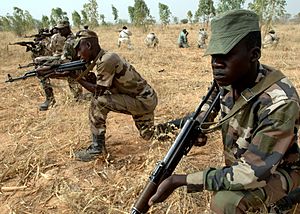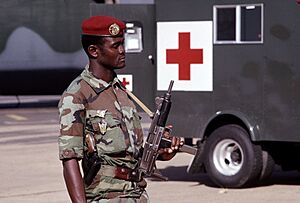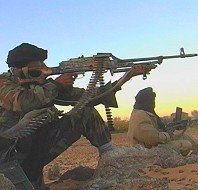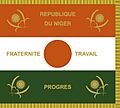Niger Armed Forces facts for kids
Quick facts for kids Niger Armed ForcesForces armées nigériennes |
|
|---|---|
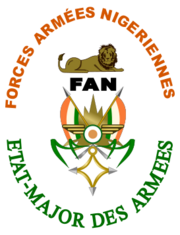 Seal of the Niger Armed Forces |
|
| Established | 1 August 1961 |
| Parts | Army Air Force National Gendarmerie National Guard (GNN) |
| Headquarters | Niamey |
| Leadership | |
| Commander-in-Chief | Brigade General Abdourahamane Tchiani |
| Chief of Staff | Divisional General Abdou Sidikou Issa |
| Serving soldiers | |
| Military age | 18–49 |
| Conscription | 2 year compulsory |
| Available to be a soldier |
2,135,680 (2005 est.), age 15–49 |
| Fit to be a soldier |
1,155,054 (2000 est.), age 15–49 |
| Active employees/soldiers | 25,000 (2020 est.) |
| Expenditures | |
| Percent of GDP | 1.8% (2017 est.) |
| Industry | |
| Suppliers from foreign countries |
Russia China United States Historical:
|
| See also | |
| History | Tuareg rebellion (1990–1995) Tuareg rebellion (2007–2009) United Nations Operation in Côte d'Ivoire Boko Haram insurgency Islamist insurgency in the Sahel 2023 Nigerien coup d'état Nigerien crisis |
| Ranks | Military ranks of Niger |
The Niger Armed Forces (French: Forces armées nigériennes, FAN) are the official protectors of the country of Niger. They include the main military groups like the Niger Army and the Niger Air Force. They also have other important groups such as the National Gendarmerie of Niger and the National Guard of Niger. Even the National Police of Niger works closely with them.
The Army, Air Force, and National Gendarmerie are managed by the Ministry of Defense. The National Guard and National Police are overseen by the Ministry of Interior. Most of these groups get military training. The President of Niger is the top leader of all the armed forces. In 2020, Niger planned to grow its army from 25,000 people to 100,000 by 2030.
Contents
How the Military is Organized
The Niger Army and Niger Air Force are the two main military groups. Each has its own Chief of Staff. These chiefs work with the Joint Chiefs of Staff of Military Armed Forces. This is like a main team that plans military actions. All military operations are led from the Joint Staff Office.
The Joint Chief of Staff is in charge of all military forces. This person reports to the civilian Minister of Defense. The Minister then reports to the President of Niger. This system is very similar to how the French military is set up.
The President also chooses a special Chief of Staff for their own office. They also pick the head of the Presidential Guard. These people report directly to the President. They are also part of the main Joint Staff team.
The Niger Army
The Niger Army is the land part of Niger's armed forces. As of 2023, it has about 33,000 members. Niger's special forces include two special operations companies. They also have nine intervention commando battalions. The Army's main fighting groups have 14 combined infantry battalions. There is also one river company that works on water.
The Army also has one engineer company, which builds things. It has one logistics group, which handles supplies. There is also one air defense company to protect against air attacks. Each combined battalion has different parts. These include a logistics company, a fire fighter company, and an infantry company. They also have an armored squadron and an artillery company.
Army History
The Niger Army started on July 28, 1960. At first, it was made up of soldiers from the French Colonial Forces. These soldiers were from Niger but had French officers. In 1960, there were only ten African officers in the army. Over time, more Nigerien officers took charge. In 1965, President Hamani Diori stopped using foreign military officers. However, some French military people stayed in Niger.
In 1970, the army was changed. It was split into four infantry battalions and other groups. In 2003, it was reorganized again. This created the Niger Air Force as its own separate group.
Army Training
Basic training for soldiers happens in Niamey at the Tondibiah base. It also takes place in Agadez. Other special training schools are in Niamey. These include the National Officers Training School. There is also a school for medical staff.
Nigerien army officers also train in other countries. They go to France, Morocco, Algeria, and the United States. Niger's army has worked with France and the U.S. to improve its skills. This helps them fight terrorism in West Africa. The Niger Army has hosted the U.S. led Flintlock Exercise in 2014.
Army Equipment
The Niger Army does not have many modern armored vehicles or tanks. Most of its armored vehicles are over 20 years old. However, they have many 4x4 Toyota Land Cruisers. These vehicles have different types of machine guns. The army has also improved its fuel and water trucks. This helps them with long patrols and moving supplies.
Armor
| Name | Origin | Type | In service | Notes |
|---|---|---|---|---|
| Armored fighting vehicle | ||||
| ZFB-05 | Armoured personnel carrier | 8 | ||
| WZ-523 | Armoured personnel carrier | 2 | ||
| UR-416 | Armoured personnel carrier | 8 | ||
| Mamba Mk7 | Armoured personnel carrier | 35 | ||
| Puma M36 | Armoured personnel carrier | 11 | ||
| Panhard VBL | Armored car | 7 | ||
| AML 60/90 | Armored car | 125 | ||
| Panhard M3 | Armoured personnel carrier | 32 | ||
| Nurol Ejder | Mine-resistant ambush protected | On order. | ||
The Niger Air Force
Air Force History
The Niger Air Force started as the Niger National Escadrille in 1961. It was later called the National Air Wing in 1989. Before 2003, all of Niger's armed forces were in one group. One Chief of Staff was in charge of both ground forces and the Air Wing.
In 2003, the armed forces were reorganized. They were split into two main parts: the Niger Army and the Niger Air Force. The National Air Wing was renamed the Niger Air Force on December 17, 2003. Now, the Air Force has its own Chief of Staff. This person reports to the Joint Chief and the Defense Minister.
Air Force Structure
The Air Force has a Chief of Staff Office. It also has units for operations and technical work. There is an infantry company and a general staff. The current Chief of Staff of the Niger Air Force is Colonel Abdoul Kader Amirou.
Air Force Training
Niger does not have special training places for its Air Force yet. New Air Force members get basic training at the Tondibiah base. This is the same place where other military groups train. Air Force officers, pilots, and mechanics also train in France, the United States, and North African countries like Morocco and Algeria.
They also do local training with foreign partners. This helps them keep their skills up to date. In 2014, the United States helped train a logistics company. They also gave them trucks and vehicles. The United States Air Force has bases in Niger, near Niamey and in Agadez.
Air Force Aircraft
The Niger Air Force has a small number of aircraft. However, they have been getting more since 2008. France and the United States have also helped. This increase in aircraft helps with border patrols. It is important because of problems in nearby Libya and Mali.
| Aircraft | Origin | Type | Variant | In service | Notes |
|---|---|---|---|---|---|
| Combat Aircraft | |||||
| Sukhoi Su-25 | Soviet Union | attack | 2 | ||
| Transport | |||||
| Dornier 228 | Germany | transport | 1 | ||
| Cessna 208 | United States | utility | 4 | 2 units are used for reconnaissance | |
| Beechcraft Super King Air | United States | transport | 350 | 1 | |
| Lockheed C-130 Hercules | United States | transport | C-130H | 3 | |
| Helicopters | |||||
| Bell 412 | Italy | transport / SAR | AB-412 | 4 | |
| Mil Mi-17 | Russia | transport | 2 | 1 unit crashed in 2024 | |
| Mil Mi-24 | Russia | attack | Mi-24/35 | 1 | 2 on order |
| Aérospatiale Gazelle | France | scout / anti-armor | SA342 | 5 | |
| Trainers Aircraft | |||||
| TAI Hürkuş | Turkey | advanced basic trainer | B | 2 | |
| Unmanned aerial vehicle | |||||
| Bayraktar TB2 | Turkey | UCAV | 6 | ||
Other Security Forces
Niger also has two other important security groups. These are the National Gendarmerie of Niger and the National Guard of Niger. The Gendarmerie is under the Ministry of Defense. The National Guard is under the Ministry of Interior. Each of these groups has its own Chief of Staff.
National Gendarmerie
The National Gendarmerie is led by its Superior Commander. It is different from the National Police and National Guard. This group is controlled by the Ministry of Defense. It helps with defense and keeping public order. It also helps with military justice and police work. The Gendarmerie is seen as a special force. This is because it has very strict rules for who can join. Its work has increased in border areas. This is due to more illegal goods being moved across borders.
National Guard
The National Guard of Niger used to be called the National Forces of Intervention and Security. This group is in charge of safety in rural areas. These are places where the national police are not present. The National Guard is overseen by its superior commander. This person reports to the Ministry of Interior.
The National Guard has many duties. It watches the country's borders and land. It helps keep and bring back order. It protects public buildings, people, and their belongings. It also manages and watches prisons. The Guard helps people during national disasters. It also protects the environment. They also provide security for government officials and foreign offices.
National Police
The main office of the National Police is in Niamey. Before 1999, it was under the military and the Ministry of Defense. Now, only the National Gendarmerie reports to the Ministry of Defense. The National Police and its special unit, FNIS, are under the Nigerien Interior Ministry.
The National Gendarmerie and the National Forces for Intervention and Security (FNIS) have about 3,700 members. These are like paramilitary police. The FNIS and some Gendarmerie units are trained like soldiers. The Gendarmerie works outside of Niger's main towns. The National Police patrols inside the towns. The military or other groups can carry out special security actions.
Niger's Role in Conflicts
Domestic Challenges
From 1985 to 1995, Niger's armed forces fought with a group called the Popular Front for the Liberation of Niger (FPLN). This led to border closings and people moving away from certain areas. In 1990, an attack by FPLN members caused the army to respond. This led to more fighting until a peace agreement in 1995.
From 2007 to 2009, the Nigerien Armed Forces were involved in another conflict in the north. A new group called the Niger Movement for Justice (MNJ) appeared. This group, mostly Tuareg people, wanted more development in the north. They attacked military places and laid landmines. This made the area unsafe and hurt tourism. The conflict ended in 2009 with peace talks.
Helping Other Countries
In 1991, Niger sent 400 soldiers to help in the Gulf War. Niger also sends peace-keeping forces to the UN Mission in Ivory Coast. As of 2003, Niger's forces were helping in other missions. These included missions in Liberia, Guinée-Bissau, Burundi, Comoros, Mali, Rwanda, and the Democratic Republic of Congo.
Working with Other Nations
Niger's defense forces have a long history of working with other countries. They cooperate with nearby nations, France, the United States, and China.
Through groups like ECOWAS and the African Union, Niger's forces have joined many missions in Africa. Niger has offered to help with future rapid intervention forces for the African Union. Also, Niger, Nigeria, Cameroon, and Chad have worked together more. This helps them fight the group Boko Haram, which crosses borders.
After the September 11 attacks, the U.S. and France worked more closely with Niger. This was part of the Global War on Terror. Niger's forces became key partners in fighting terrorism in Africa. This work focused on groups linked to Al-Qaïda. The problems in Libya and Mali made Niger's role even more important. Since 2013, the air force base 101 in Niamey has been used by French and U.S. forces for drones. This base helps gather information in the region.
In March 2024, Niger said it was ending its security agreement with the United States. This agreement had been in place since 2012. Niger stated that the agreement went against its constitution.
How the Forces are Managed
The Armed Forces, including the National Gendarmerie, have changed over time. These changes aim to make the forces more professional. They also want to keep more skilled recruits. There is now more focus on recruiting officers. More training is needed for promotions. Each year, about one thousand people join the Army and the Gendarmerie.
Budget and Foreign Aid
Niger's defense budget is not very large. It makes up about 1.6% of what the government spends. France gives the most military help to Niger. China also provides military assistance. About 18 French military advisors are in Niger. Many Nigerien military members train in France. The Nigerien Armed Forces mostly use equipment given or bought from France.
The United States has helped by training pilots and support staff. They also provide education for officers. A small program for foreign military help started in 1983. A U.S. Defense Attaché office opened in 1985. This office closed in 1996 after a change in government. It reopened in 2000.
In 2003, the U.S. helped transport Nigerien troops to Ivory Coast. The U.S. also provided training and equipment to Nigerien soldiers. This was part of a program called the Pan Sahel Initiative. Military cooperation continues through other programs. In 2007, Niger's military was allowed to join the International Military Education and Training (IMET) program. This program funded $170,000 in training in 2007.
Cultural Activities
The Army, National Guard, and National Police support semi-professional football clubs. These clubs are called ASFAN, AS-FNIS, and AS Police. They play in the Niger Premier League.
Images for kids


